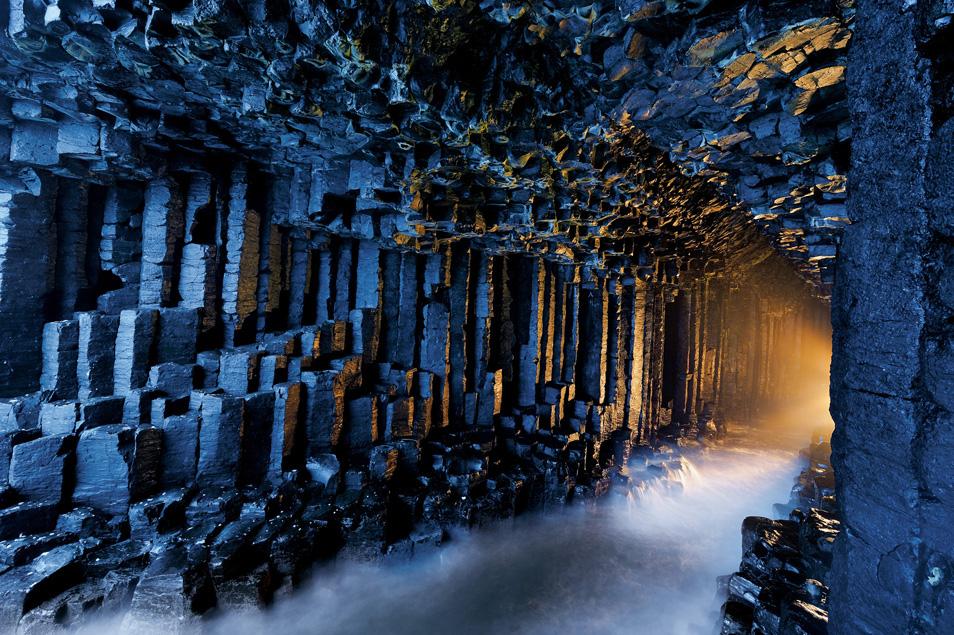Fingal’s Cave, in Scotland


Fingal’s cave is a cave the marina on the Staffa Island, in the islands of the inner Hebrides, Scotland, and is part of a nature reserve. The island has only a kilometer long and half a kilometer wide. Its area is 33 hectares and the highest point above sea level rises to 42 meters. Endless rain and the waves created in this small piece of land around the cave system. The largest of the caves was named in honor of the giant Fingal – a hero of the epic poetry of Ireland.
Is formed by basalt hex, similar in structure to the Giants Causeway in North Ireland, with whom he shares the same origin of lava flow. Its size, its ceiling of natural arches and the chilling sounds produced by the echoes of waves, give it the atmosphere of a natural Cathedral.
The main hall of the Fingal cave has a length of 75 metres, a width of 20 meters and a height of 14 meters. In the Gaelic language, this cave was called Uamh-Binn (cave of melodies). Its name in honor of the epic poetry of Fingal (Finn McCool) cave received the Scottish poet James Macferson. According to Irish legend the Fingal giant built the dyke linking Scotland with Ireland.

Cave was discovered in the 18th century by the naturalist Sir Joseph Banks in 1772. Became known as Fingal’s profile, maybe Fingal (Finn McCool) was the eponymous hero of a poem written by the poet and Scottish historian James Macpherson.
In 1829 when he was twenty years old, Félix Mendelssohn undertook a long trip to Scotland. The letters that, for this reason, wrote clearly show the deep impression that in his spirit produced the beauties of the landscape and the atmosphere of those places, so lavish in history. Mendelssohn feelings were reflected in two of his best-known works: the Scottish Symphony and the Overture the Hebrides, also known by the name of the Fingal’s Cave.
The circumstances which inspired this composition are well known. Accompanied by his friend Klingemann Mendelssohn, undertook a maritime tour under a stormy sky. Was particular object of your trip visit to the Grotto Fingal, main curiosity of the Hebrides.

The knowledge of this cave, beautiful spot located on the island of Staffa, ripped to Klingemann pen these lit paragraphs:
«did three days ago that we were on Board of our boat. The more descending barometer, more grew to the height of the waves, thousands of languages tesoneras licked the boat with increased fury and eddies of water increased in violence at times… The ladies were plunging as flies, and some that another gentleman happened the same. I wanted that my travelling companion, Felix, is not among them, but his soul of artist was able to withstand the pounding of the sea much better doing that your stomach… Did us deal with boats, and perched on a stand of timber logs, thus, reach, riding a foaming sea, the famous Cave of Fingal, whose numerous columns remind a colossal organ inside. Both inside and outside, solitary shady, thunderous and prismatic, demonstrating its immense inanity, the grey sea stretched infinite to get lost in the horizon… »
so vivid description clearly evokes the strange atmosphere of the place and the vicissitudes of the boat excursion. Mendelssohn composed the Overture influenced directly by the impression that such experience was in his mind. In a letter dated August 7, 1829, to his sister Fanny, wrote: «can understand how extraordinarily impressed by the Hebrides. «What follows (and later would be the the first ten bars of the Overture) came me to the imagination». The composer completed the work on December 16, 1830, and was originally titled it Die einsame Insel, «The lonely island» and deserved the honours of his debut in the British capital, under the direction of Thomas Atwood, in front of the London Philharmonic.

However, the own Mendelssohn, little satisfied of its composition, wrote shortly afterwards: «not consider it complete in its current form. The central passage is bad; It smells more counterpoint than waves, seagulls and salted fish». The score was revised during the next year and took a second premiere in Berlin on January 10, 1833, under the baton of the composer. The work was dedicated to Federico Guillermo IV King of Prussia, at that then Prince of Prussia.